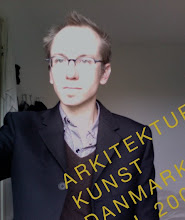

Click to Enlarge.
Left to right, from the top:
Thorvaldsen's Musem
Danish Sculptor, lived and worked in Rome for 40 years. The museum opened in Copenhagen in 1848 and this wing on the top floor is exactly the same as it was on opening day. There are a series of rooms containing beautiful wood and glass cabinets that display Thorvaldsen's personal collection of Egyptian, Greek, and Roman antiquities. Each wing is designed to have a long enfilade of 8-10 rooms. (shown in the picture)
Nicolaj
This is housed in a 13th century church, and shows mainly contemporary art. While I enjoyed the painting show (Link here:
Paul Gadegaard) the conversion of the church into an art venue seemed a bit, well, unconverted. Perhaps they just have a lack of funding, but for example, instead of just whiting out the whole space, they painted a white stripe across the bottom fifteen feet or so, level with the temporary partition walls. The general effect is one that implies the museum is only temporarliy squatting in the church, rather than fully altering the use. While this might seem more poetic, I think the place would be more powerful if it "colonized" the old building a little more.
Cisternerne
Ok, this museum gets the strangest use of an old space award. Modern glass art is shown in the raw, underground spaces of an old water reservoir beneath a green lawn at Frederiksberg Park. There is a small pavilion above ground that acts as ticket booth and entrance while the extensive concrete spaces below are left practically unchanged. The floors are wet with seeping water and there was a big squeegy mop by the main hall implying that the floors must require a certain amount of maintenance every day. I guess they figured glass art would hold up best under these conditions and could be successfully lit with electric light down in this very dark cavern, but the end result is a bit weak. Maybe its my architectural prejudices, but I would have been just as happy if there hadn't been any art on display in this place! Well, there was one really nice room that held full size human figure stone sculptures circa 1700s, that really activated the column-filled space to the effect of "tomb." The acoustics were incredible down there (garbling and looping any distant visitors speech into an ambiance on par with old Cocteau Twins records) and the wet, drippy floors intense and creepy (in a good way). I couldn't get a good picture of the huge rooms that seemed to keep on going, and going... because of the low light levels. My new camera doesn't have the handy 5-10 second exposure option my good old canon had. Link to
Cisternerne's site here.Gammel Strand
This small museum located in the city center is in an old house designed by danish architect Philip de Lange. The building is easy to miss, as it is simply part of a continuous urban block of buildings, rather than a stand alone feature. This humble quality is fantastic for showing young contemporary artists (their focus) because of the often great contrast between the very "homey" interiors and the often challenging imagery and content of 21st century art. This photo shows a beautiful brass, steel and wood stair that may be original...
































